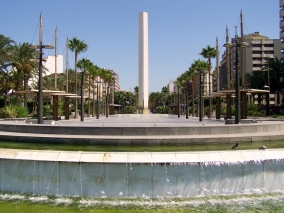Spanish schools and accommodation to study Spanish in Spain
Recent posts
Last schools
introduced
introduced
2 Accommodation

1 Spanish schools

Learning Spanish in Almeria. The tourist guide to study your Spanish course.
General Information. 190,000 inhabitants. 552 kilometres to the south of Madrid. It belongs to the Autonomous Community of Andalusia. Almeria is surrounded by two sierras, Gádor and Alhamilla, and by the valley and delta of the Andarax River. The city was founded as far back as 995 BC by Abderramán III. Almeria was the most important port in Al-Ándalus during the Omeya Caliphate, and enjoyed its greatest moment of splendour as an independent city-state (Taifa) in the 11th century. The university was founded in 1993 and is one of the most recently opened in Spain, offering places to 12,300 students in 2009-2010. Almeria is a very attractive place to study Spanish with some language schools offering a wide range of courses.
Surrounding Areas. Cabo de Gata (30 kilometres) and its nature reserve, with unspoilt beaches and fishing villages; Níjar (40 kilometres), near the Cabo de Gata Nature Reserve (Parque Natural de Cabo de Gata); the gold mines of Rodalquilar (56 kilometres); Roquetas de Mar (20 kilometres); Mojacar (88 kilometres); and the Tabernas desert (30 kilometres), with its spectacular sunrises and sunsets.
Main sights. The Moorish Alcazaba (10th to 15th century), an ancient Arab fortress of the Taifa government. The Wall of Jairán, which ascends to the top of the San Cristóbal hill, where the remains of the first Christian fortress can be seen (1147). Other monuments include the 16th century Cathedral of Our Lady of the Incarnation (Catedral de Nuestra Señora de la Encarnación), with its fortress-like design; the ‘English Cable' (Cable Inglés) mineral loading platform (late 19th century); the monument to the Freedom Martyrs (Mártires de la Libertad) in the Plaza de la Constitución; the Statue of Charity (Estatua de la Caridad) and the Butterfly House (Casa de las Mariposas), in the port of Purchena.
Culture. The Almeria Flamenco Festival, the oldest of its kind in Andalusia, has an enormous impact throughout Spain (second fortnight of August). The International Jazz Festival (between October and November) held in the Apollo Theatre (Teatro Apolo). The International Short Film Festival, "Almeria en Corto" (December). The following museums are worthy of mention: the Museum of Almeria (Museo de Almeria), the Andalusian Centre of Photography (Centro Andaluz de Fotografía), the Civil War Shelter (Refugio de la Guerra Civil), the Seismology Museum (Museo de Sismología)... Also, the Maestro Padilla Auditorium, with concerts and theatrical productions.
Beaches. The beaches of Cabo de Gata and Níjar are renowned for being quiet and unspoilt. They are situated between picturesque and traditional fishing villages in an extensive area defined by Cabo de Gata itself, to the east of Almeria. The city also has its own good beaches, and to the west there are two tourist resorts, Aguadulce and Mojácar, both of which offer a wide range of hotels and restaurants. The beaches are a major attraction for the many students who decide to study Spanish in Almeria.
Shopping. Here you will be able to find the finest handicraft products: pottery, tapestries, embroidery, leather goods, esparto grass... The most important shopping centres are Gran Plaza in Roquetas de Mar and the Mediterráneo, which is within easy reach of the city.
Gastronomy. It is worth highlighting that Almeria has a very strong culture of tapeo, the popular Spanish custom of accompanying each drink with a small snack while bar-hopping, and there are many places to take tapas throughout the city, especially in the centre. Pescadería, El Alquián and Cabo de Gata are all highly recommended as places to try the local fresh fish. Typical dishes are: migas (fried bread crumbs), patatas a lo pobre (potatoes fried with onions and peppers), and embutidos (different types of sausage and cold cuts), all of which are best sampled in some of the inland villages. The region also has some exquisite desserts, many of Arab origin.
Sports. Water sports and scuba-diving are the most attractive sports in the city, and you can learn these sports here. There are also numerous golf courses. Almeria was chosen to host the 15th edition of the Mediterranean Games in 2005, and the sports stadium of the same name that was built to coincide with the Games is currently home to the city's football team, Unión Deportiva Almeria, who play in the Spanish First Division. Almeria's volleyball team have been champions of Spain and Europe on several occasions. The Emilio Capra Athletics Stadium (Estadio de Atletismo Emilio Capra), which is also known as "The Stadium of Youth", hosts athletics and football competitions.
Fiestas. The main fiesta is dedicated to Almeria's patron saint, the ‘Virgin of the Sea' (second fortnight in August). The city's Holy Week has been declared an Event of National Tourist Interest. Another attractive fiesta is the Carnival, famous in Spain for its choral and popular music contests and its murgas and comparsas (two special types of carnival song).
Transport. Almeria has its own tourist train that sets off from Plaza Emilio Pérez. It runs on Saturdays and Sundays all year round. It is easy to get from Almeria to other Spanish cities by train or by using the various coach services.
Nightlife. Students who decide to study Spanish in Almeria will discover a very active nightlife. When the locals go out at night, their favourite haunt is the city centre and especially the areas in and around a hotspot known as ‘the four streets'. In summer, the marina is more popular, with its numerous bars and lively atmosphere.
Surrounding Areas. Cabo de Gata (30 kilometres) and its nature reserve, with unspoilt beaches and fishing villages; Níjar (40 kilometres), near the Cabo de Gata Nature Reserve (Parque Natural de Cabo de Gata); the gold mines of Rodalquilar (56 kilometres); Roquetas de Mar (20 kilometres); Mojacar (88 kilometres); and the Tabernas desert (30 kilometres), with its spectacular sunrises and sunsets.
Main sights. The Moorish Alcazaba (10th to 15th century), an ancient Arab fortress of the Taifa government. The Wall of Jairán, which ascends to the top of the San Cristóbal hill, where the remains of the first Christian fortress can be seen (1147). Other monuments include the 16th century Cathedral of Our Lady of the Incarnation (Catedral de Nuestra Señora de la Encarnación), with its fortress-like design; the ‘English Cable' (Cable Inglés) mineral loading platform (late 19th century); the monument to the Freedom Martyrs (Mártires de la Libertad) in the Plaza de la Constitución; the Statue of Charity (Estatua de la Caridad) and the Butterfly House (Casa de las Mariposas), in the port of Purchena.
Culture. The Almeria Flamenco Festival, the oldest of its kind in Andalusia, has an enormous impact throughout Spain (second fortnight of August). The International Jazz Festival (between October and November) held in the Apollo Theatre (Teatro Apolo). The International Short Film Festival, "Almeria en Corto" (December). The following museums are worthy of mention: the Museum of Almeria (Museo de Almeria), the Andalusian Centre of Photography (Centro Andaluz de Fotografía), the Civil War Shelter (Refugio de la Guerra Civil), the Seismology Museum (Museo de Sismología)... Also, the Maestro Padilla Auditorium, with concerts and theatrical productions.
Beaches. The beaches of Cabo de Gata and Níjar are renowned for being quiet and unspoilt. They are situated between picturesque and traditional fishing villages in an extensive area defined by Cabo de Gata itself, to the east of Almeria. The city also has its own good beaches, and to the west there are two tourist resorts, Aguadulce and Mojácar, both of which offer a wide range of hotels and restaurants. The beaches are a major attraction for the many students who decide to study Spanish in Almeria.
Shopping. Here you will be able to find the finest handicraft products: pottery, tapestries, embroidery, leather goods, esparto grass... The most important shopping centres are Gran Plaza in Roquetas de Mar and the Mediterráneo, which is within easy reach of the city.
Gastronomy. It is worth highlighting that Almeria has a very strong culture of tapeo, the popular Spanish custom of accompanying each drink with a small snack while bar-hopping, and there are many places to take tapas throughout the city, especially in the centre. Pescadería, El Alquián and Cabo de Gata are all highly recommended as places to try the local fresh fish. Typical dishes are: migas (fried bread crumbs), patatas a lo pobre (potatoes fried with onions and peppers), and embutidos (different types of sausage and cold cuts), all of which are best sampled in some of the inland villages. The region also has some exquisite desserts, many of Arab origin.
Sports. Water sports and scuba-diving are the most attractive sports in the city, and you can learn these sports here. There are also numerous golf courses. Almeria was chosen to host the 15th edition of the Mediterranean Games in 2005, and the sports stadium of the same name that was built to coincide with the Games is currently home to the city's football team, Unión Deportiva Almeria, who play in the Spanish First Division. Almeria's volleyball team have been champions of Spain and Europe on several occasions. The Emilio Capra Athletics Stadium (Estadio de Atletismo Emilio Capra), which is also known as "The Stadium of Youth", hosts athletics and football competitions.
Fiestas. The main fiesta is dedicated to Almeria's patron saint, the ‘Virgin of the Sea' (second fortnight in August). The city's Holy Week has been declared an Event of National Tourist Interest. Another attractive fiesta is the Carnival, famous in Spain for its choral and popular music contests and its murgas and comparsas (two special types of carnival song).
Transport. Almeria has its own tourist train that sets off from Plaza Emilio Pérez. It runs on Saturdays and Sundays all year round. It is easy to get from Almeria to other Spanish cities by train or by using the various coach services.
Nightlife. Students who decide to study Spanish in Almeria will discover a very active nightlife. When the locals go out at night, their favourite haunt is the city centre and especially the areas in and around a hotspot known as ‘the four streets'. In summer, the marina is more popular, with its numerous bars and lively atmosphere.
© TEXT: SPANISH IN TOUR.
VIDEO: Patronato de Turismo de Almeria
VIDEO: Patronato de Turismo de Almeria























